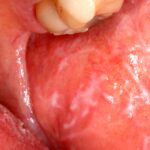
Oral lichen planus is a chronic or recurrent inflammatory autoimmune disease of the oral mucosa that affects between 0.5-2.0% of the population being more common over the age of 40. A number of studies and reviews have suggested a malignant transformation rate of about 1.2% which supports the classification of oral lichen planus as an oral potentially malignant disorder (OPMD).
The main aim of this review was to report the most realistic oral lichen planus malignancy proportion with the highest quality of evidence.
Methods
Searches were conducted in the PubMed, Embase, Web of Science, and Scopus databases. longitudinal studies on malignant transformation in oral lichen planus (OLP) published in English and scoring higher than 75% on the Quality in Prognosis Studies (QUIPS) tool (Hayden et al,2013) for qualitative evaluation were considered. Two reviewers selected studies, assessed study quality with the QUIPs tool and extracted data. Malignant transformation was expressed as a percentage with 95% confidence intervals (95%CI). The certainty of evidence was evaluated using the Grading of Recommendations Assessment, Development and Evaluation (GRADE system).
Results
- From 89 studies potentially meeting the inclusion criteria 10 high-quality studies were included.
- Studies were conducted in Australia, Israel, Italy, New Zealand, Spain, Switzerland and the USA.
- Sample size of the 10 studies ranged from 102 – 829 patients including in all a total of 3403 patients.
- 3206 patients had OLP, and 197 patients had oral lichenoid lesions (OLL).
- 86 patients developed oral cancer 80 with OLP and 6 with OLL.
- Meta-analyses showed an overall malignant transformation rate (MTR) of 2.28% for OLP and 2.11% for OLL
- OLP MTR = 2.28 (95%CI; 1.49 to 3.20) [10 studies].
- OLL MTR = 2.11 (95%CI; 0.01 to 6.33) [3 studies].
- The certainty of evidence for MTR is OLP and OLL was assessed as moderate.
Conclusions
The authors concluded: –
We observe that the proportion of malignancy is higher in research carried out under strict methodological quality criteria. In this critical review, we propose criteria for conducting follow-up studies on OLP to report on malignant transformation under strict quality standards.
Comments
This group have published an earlier review of this topic (González-Moles et al, 2019) which is one of a number of reviews conducted (Dental Elf – 27th Mar 2020; Dental Elf – 17th Aug 2017). This review conducted follow a standard systematic review protocol focuses only on studies published since 2000 and with stricter inclusion and exclusion criteria. However, as they have excluded non-English studies it is possible that they may have excluded some studies that could have met their stricter conditions. While the 10 included studies scored highly on the QUIPs tool 8 out of the 10 studies were still retrospective in nature. Comparing this review with the groups earlier paper a higher rate for malignant transformation (MTR) was seen for both OLP and OLL when only the higher quality studies were considered (see table).
| OLP -MTR
(95%CI) |
OLL-MTR
(95%CI) |
|
| González-Moles et al, 2019 | 1.14% (0.84 to 1.49) | 1.88% (0.15 to 4.95) |
| González-Moles et al, 2021 | 2.28% (1.49 to 3.20) | 2.11% (0.01 to 6.33) |
The groups 2019 review contained 82 papers with many being assessed as low quality. As a result, the author’s discuss potential methodological criteria for future studies. Ideally more of these should be prospective in nature. In recent years much work has been done on developing guidelines for the conduct and reporting of studies (EQUATOR Network) and the agreement of common outcome sets (COMET Initiative) having international consensus in relation to OLP would be beneficial for researchers and patients alike. The review authors also propose clinical and histopathological criteria for the diagnosis of OLP and international agreement on this would also be helpful.
Links
Primary Paper
González-Moles MÁ, Ramos-García P, Warnakulasuriya S. An appraisal of highest quality studies reporting malignant transformation of oral lichen planus based on a systematic review. Oral Dis. 2021 Nov;27(8):1908-1918. doi: 10.1111/odi.13741. Epub 2020 Dec 24. PMID: 33274561.
Other references
Hayden JA, van der Windt DA, Cartwright JL, Côté P, Bombardier C. Assessing bias in studies of prognostic factors. Ann Intern Med. 2013 Feb 19;158(4):280-6. doi: 10.7326/0003-4819-158-4-201302190-00009. PMID: 23420236.
González-Moles MÁ, Ruiz-Ávila I, González-Ruiz L, Ayén Á, Gil-Montoya JA, Ramos-García P. Malignant transformation risk of oral lichen planus: A systematic review and comprehensive meta-analysis. Oral Oncol. 2019 Sep;96:121-130. doi: 10.1016/j.oraloncology.2019.07.012. Epub 2019 Jul 22. PMID: 31422203.
Dental Elf – 27th Mar 2020
Dental Elf – 17th Aug 2017
Dental Elf – Oral Lichen Planus Blogs
Picture Credits
“File:Lichen planus.jpg” by Ian Furst is licensed under CC BY-SA 4.0
